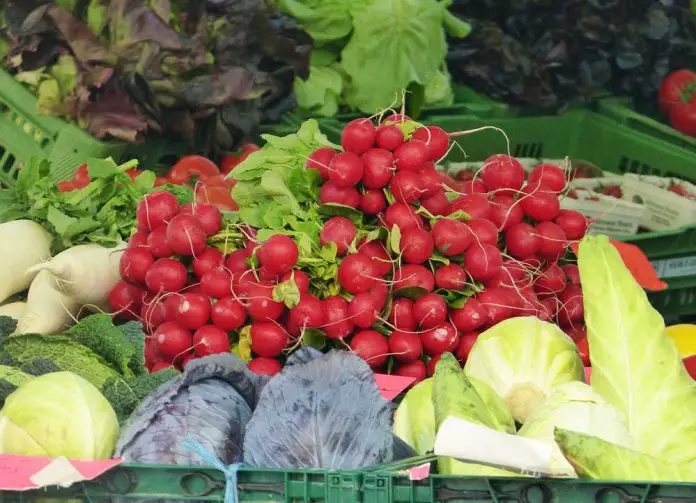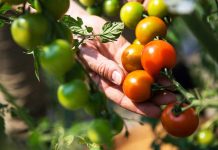There’s no such point as foolproof veggie horticulture, but container veggie horticulture comes nearby decreasing the risks positioned by weather and critters. Another great benefit of container horticulture is that you don’t need a large space or in-ground yard spot.
Some of the easiest veggies to expand in containers are nightshades such as tomatoes, potatoes, peppers, and eggplant, as well as fast-growing crops such as peas and lettuce. Have a look at 10 veggies that you could expand also if you don’t have a yard plot but do have an outdoor patio, patio, or terrace with great sunlight direct exposure.
Tips: A larger volume of soil will hold moisture and nutrients longer. You might consider starting with a larger container than you think you need to reduce your margin of error.
1. Tomatoes (Solanum Lycopersicum)
Expanding tomatoes in containers is easy and extremely satisfying. Most tomatoes also are happiest in big containers and will need staking or a tomato cage. This support maintains the hefty fruit from flexing and breaking the vines.
If you’re buying tomato seedlings, appearance for brief, stocky plants that don’t have blooms yet. Tomatoes don’t such as the chilly, so don’t put them out prematurely. Make certain you harden off or slowly adjust seedlings to outside living before you grow them.
When growing tomato seedlings, grow them deeply—much deeper compared to what you do most plants. Also, maintain canines and felines far from this growth, the fallen leaves are harmful if ingested by pets.
- USDA Growing Zones: 8 to 11
- Sun Exposure: Full sun
- Soil Needs: Deep, moist, good drainage
2. Peas (Pisum Sativum)
Peas can be grown in very early springtime and however when it obtains cool in the fall. There are 3 kinds of peas: English peas, snow peas, and sugar snap peas. They are perfect for sequence growing by enriching the dirt with nitrogen. Grow them in very early springtime. Once it obtains warmth, and they finish creating, draw them out, and grow another thing because of container. Nitrogen is important nutrition feeding the dirt for the next set of plants. Peas are also among the best veggies to expand with your children; they expand quickly and easily.
- USDA Growing Zones: 2 to 11
- Sun Exposure: Full sun
- Soil Needs: Good drainage, enriched or loamy soil
3. Potatoes (Solanum Tuberosum)
Newly picked potatoes preference completely various compared to the potatoes you buy in a supermarket. They have greater sprinkle content and a bitter, natural taste to usher in the quality of springtime.
Expanding potatoes in containers require a great deal of dirt and sprinkle but deserve the sources and initiative. Containers also include an extra degree of protection versus fungi or curse (Phytophthora infestans), which spreads out easier amongst in-ground plants.
- USDA Growing Zones: 3 to 10B
- Sun Exposure: Full sun
- Soil Needs: Good drainage, loamy soil
4. Squash (Cucurbita)
Squash is an easy veggie to expand, and squash blooms are beautiful, fragile edibles. Most squashes require a great deal of space and a reasonably large container. Its ideal expanding problems consist of great deals of light, great dirt, as well as consistent sprinkling and feeding.
If you are going to grow winter squash in a container, make sure the variety you choose is not one of the giant types, which can weigh more than 20 pounds and topple the containers. ‘Honeybear’ is an award-winning smaller variety of acorn squash, and there are even tiny pumpkins you can grow.
- USDA Growing Zones: 3 to 10
- Sun Exposure: Full sun
- Soil Needs: Rich soil, good drainage
5. Lettuce and Salad Greens (Lactuca Sativa)
Expanding lettuce and various other salad eco-friendlies in containers is fast. Container expanding gives you the versatility to control weeds and insects more easily compared to in-ground growing.
Lettuce doesn’t need as a lot of sunlight as most veggies. Some great salad eco-friendlies and mesclun blends you can buy for container yards that preference great and appearance great in decorative pots consist of Johnny’s Elegance Eco-friendlies Blend and Hudson Vally Seed Library’s Mesclun Blend.
- USDA Growing Zones: 4 to 9
- Sun Exposure: Partial sun
- Soil Needs: Moist, fertile soil
6. Hot and Sweet Peppers (Capsicum Annuum)
Both warm and wonderful peppers can be marvelously beautiful, particularly orange and purple wonderful peppers in containers. They flourish in expand boxes but can be grown in any large container with lots of sunlight, great drainage, and consistent sprinkling.
Dry dirt or excessively damp dirt is devastating for peppers. Among one of the most considerable benefits of growing peppers in containers is that you could move your plants inside if continuously rainy weather threatens your location for several days.
Peppers come in all forms, dimensions, and shades. Warm peppers range in flavor degree from mild to searing to hardly edible.
- USDA Growing Zones: 11 and up
- Sun Exposure: Full sun
- Soil Needs: Moist soil with good drainage
7. Cucumbers (Cucumis Sativus)
Cucumbers are a fast-growing veggie commonly grown in containers. These water-loving plants do best in large plastic or ceramic pots that help the dirt keep moisture.
Expanding cucumbers in containers is a great way to provide the heat they love (hotter ambient temperature levels raise dirt temperature level quicker in pots compared to in-ground).
There are 2 main kinds of cucumbers: shrub and vining. Either can expand in a container. Shrub cucumbers have the tendency to be much shorter with smaller sized yields. Vining cucumbers will require a trellis or tomato cage.
- USDA Growing Zones: 4 to 12
- Sun Exposure: Full sun to partial shade
- Soil Needs: Good drainage with moist, fertilizer-enriched soil
8. Radishes (Raphanus Sativus)
Radishes expand unbelievably quickly; most go from seed to gather in simply a month. They also don’t need a lot of space—they can expand in containers that are 4 to 6 inches deep.
These plants don’t such as obtaining too warm, but you control this easily by moving the grow right into the color or including sprinkle to cool them down.
There are many ranges, which means you can select your seeds based upon look and flavor; some kinds are gorgeous. The tops or radish eco-friendlies are also edible, as are the pods.
- USDA Growing Zones: 2 to 10
- Sun Exposure: Full sun to partial shade
- Soil Needs: Good drainage with moist soil
9. Arugula (Eruca Vesicaria)
Hot arugula fallen leaves are delicious, and its edible blossoms are a wonderful treat. They are also beautiful. Arugula doesn’t need a huge container—a pot 8 inches deep and 6 inches in size works.
Another benefit of expanding arugula in a container is that you could relocate. Arugula needs about 6 hrs of direct sunshine but doesn’t such as scorching, mid-day sunlight.
It’s best to allow this grow to obtain complete early morning sunlight and relocate or position it so that it just obtains partial sunlight in the mid-day.
- USDA Growing Zones: 3 to 11
- Sun Exposure: Full sun to partial shade
- Soil Needs: Good drainage with moist soil
10. Eggplant (Solanum Melongena)
Eggplant is among those great veggies that also works as an ornamental. Some eggplant ranges can obtain thick and heavy; don’t use those enters your container yard.
Appearance at small cultivars such as ‘Fairytale’ and ‘Hansel’ which are beautiful and delicious. Large containers are had to support the origins of this grow and their bush-like development.
Also, if you’re obtaining ceramic pots, consider obtaining polished pots, which keep sprinkles much longer.
- USDA Growing Zones: 5 to 12
- Sun Exposure: Full sun
- Soil Needs: Good drainage, evenly moist soil



